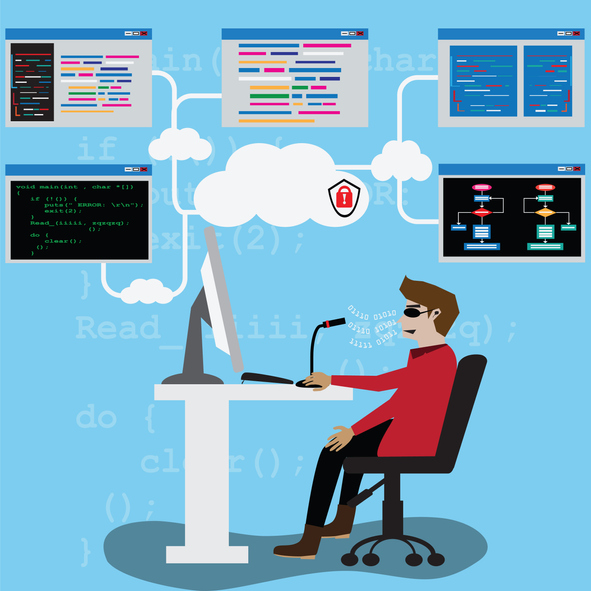
©wilkat/iStock/Getty Images Plus
In September, I had the opportunity to take part in Oracle’s OpenWorld conference. While the technologies that were announced were impressive and hold the potential to fundamentally alter the way work is performed, the most interesting session I attended wasn’t one of the keynotes detailing autonomous databases, machine learning capabilities, or a confectionery of cloud applications – it was a panel discussing how Industries for the Blind and Visually Impaired (IBVI) is embracing technology in order to further its ability to create employment opportunities for the visually impaired.
Looking at this item on the schedule, I saw it as a chance to answer emails and catch-up on work that was steadily piling up in my absence. When I sat down in the press room, I was intrigued as Emmanuel Vouvakis, Chief Innovation Officer at IBVI, and an Oracle employee assisted IBVI’s Director of Customer Success – Deborah Ambro-Crandell (a woman who is visually impaired) – onto the raised stage.
The Role of Emerging Technologies
Much of the panel consisted of how IBVI’s digital transformation – culminating in a migration from nine ERP instances to one that was cloud-based – is furthering its mission of creating opportunities for the visually impaired community. When asked about his vision for their cloud-based ERP, Vouvakis beamed “We’re looking to get into a fully integrated, intuitive, and immersive cloud experience. Where accessibility isn’t the word. It’s just a different way of approaching the system.” Vouvakis conceives of a time when we will interact with ERPs in the same way that we interact with our mobile devices, which can read texts out loud and take voice commands, asking “Why can’t my ERP be the same way?”
Vouvakis further noted that all of the OpenWorld’s keynotes discussed how the nature of the interaction between professionals and systems is changing and will continue to become more interactive and simple. Out of all of these innovations, Vouvakis noted that the “goal is for all people – in any environment – to be able to work.”
Overriding the Natural Discount
Looking beyond the visually impaired, those with disabilities face a disproportionate number of hurdles (both real and imagined), which is why the unemployment rate for those with disabilities (8.0% in 2018) is more than double those without disabilities (3.7% in 2018), according to the Bureau of Labor Statistics.
When asked about the real barriers that the visually impaired community faces in the workplace, Ambro-Crandell responded “transportation is probably the biggest barrier to employment for people that are blind. The use of cloud computing is one of the biggest leveling forces that are out there right now.” She added, “I also think that training and development for people that are blind is a problem. Educators need to know what businesses want for their talent, and we need to start developing training initiatives to get people who are blind into the workforce.”
Beyond the real barriers, Vouvakis articulated the imagined barriers that visually impaired professionals face (although it certainly applies to all professionals with a disability) saying, “There is a natural discount of people that are blind and visually impaired in society. One of the things that I’m very proud of is our employees, and their ability to think, execute, and perform those tasks that even people that are sighted cannot do very well.”
To illustrate this point, Vouvakis motioned to the frenzied activity in the press room – i.e. media members dodging one another to and from interviews, droning side conversations, and press members frenetically clacking at keyboards – culminating in one barbaric yawp. He articulated that “our minds are processing all of this information; whereas Deborah [sic] doesn’t have that problem. She can focus on this discussion and know exactly what we’re saying, so her clarity and ability to process what is going on and its acuteness is much greater than ours. Sometimes processing all of this side information benefits you, and sometimes it hurts you.”
In order to correct that discount, we must learn to focus on all the ways an employee can provide value – rather than what they lack; this mindset shift enables leaders to discover new ways of thinking, which can help them better assess their workforce, how it should expand, and the types of different perspectives that need inclusion – to which Ambro-Crandell followed up saying, “we would like everybody to see blind people with talent as potential job candidates.”
Given the higher amounts of unemployment among those with disabilities, figuring out ways to make small accommodations for employees with disabilities represents an opportunity to access an under-utilized talent pool in an ever-shrinking labor market – one that brings enthusiasm, unique skills, and fresh perspectives.
Like any high-performing professional, Ambro-Crandell mused “What I really want to be known for is doing really good work.” She further shared, “Most blind people in our organization want to come to work and do the job. Blindness is a part of who I am, but it is not a part of what I am recognized for at IBVI.”